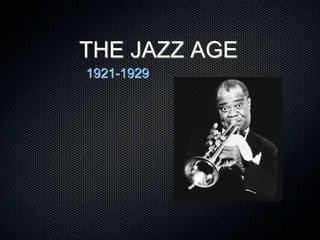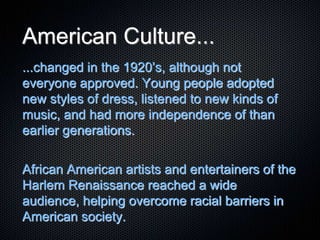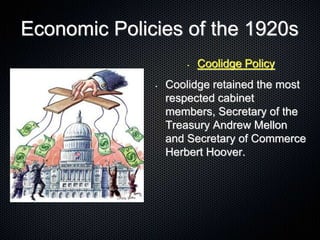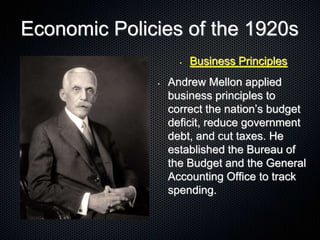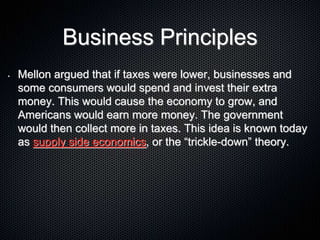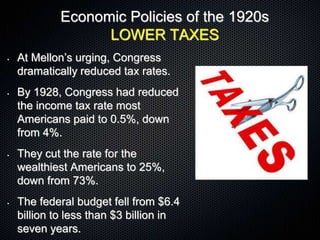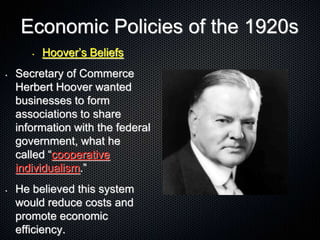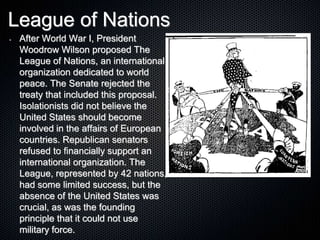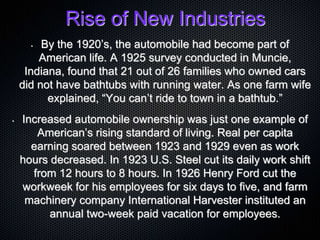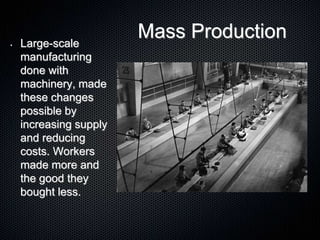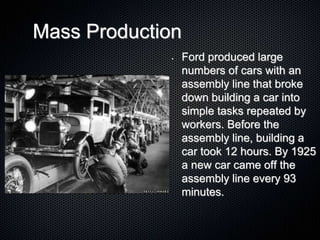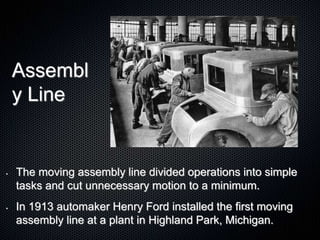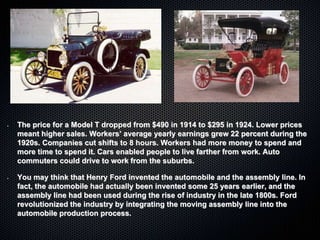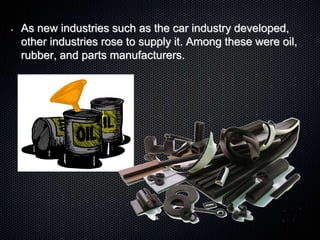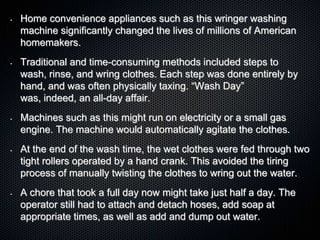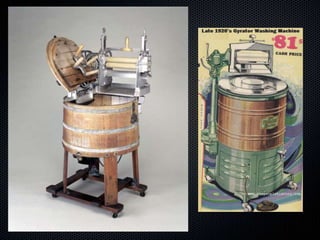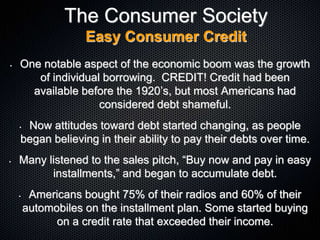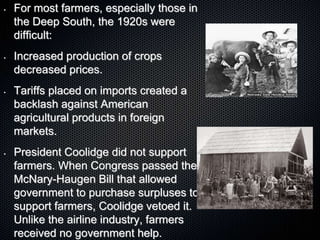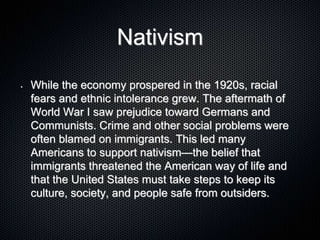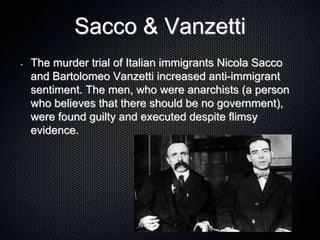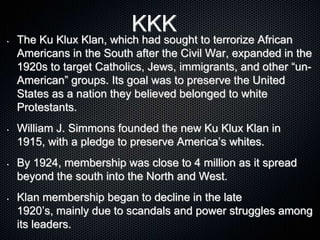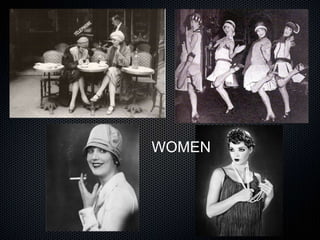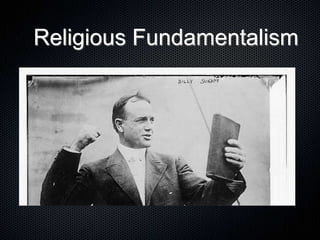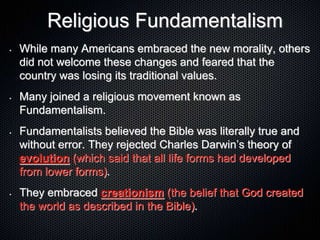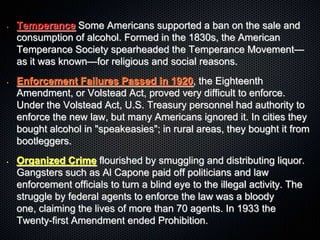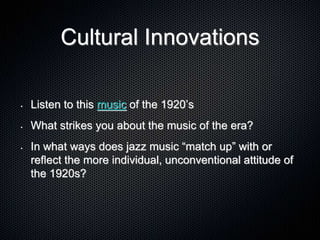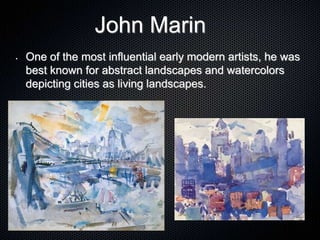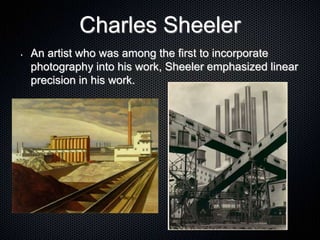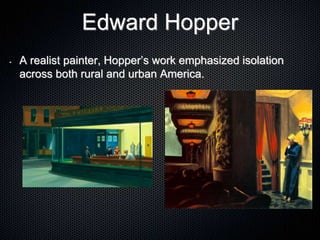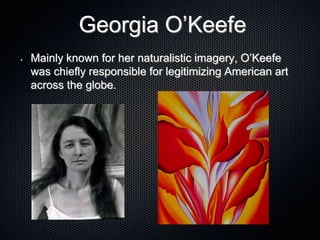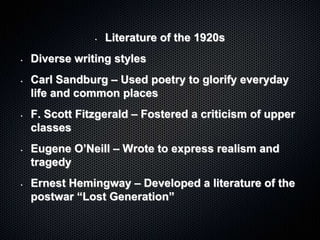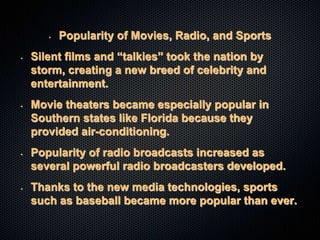The jazzage
- 2. American Culture... ...changed in the 1920’s, although not everyone approved. Young people adopted new styles of dress, listened to new kinds of music, and had more independence of than earlier generations. African American artists and entertainers of the Harlem Renaissance reached a wide audience, helping overcome racial barriers in American society.
- 3. Economic Policies of the 1920s • Coolidge Policy • Coolidge retained the most respected cabinet members, Secretary of the Treasury Andrew Mellon and Secretary of Commerce Herbert Hoover.
- 4. Economic Policies of the 1920s • Business Principles • Andrew Mellon applied business principles to correct the nation’s budget deficit, reduce government debt, and cut taxes. He established the Bureau of the Budget and the General Accounting Office to track spending.
- 5. Business Principles • Mellon argued that if taxes were lower, businesses and some consumers would spend and invest their extra money. This would cause the economy to grow, and Americans would earn more money. The government would then collect more in taxes. This idea is known today as supply side economics, or the “trickle-down” theory.
- 6. Economic Policies of the 1920s LOWER TAXES • At Mellon’s urging, Congress dramatically reduced tax rates. • By 1928, Congress had reduced the income tax rate most Americans paid to 0.5%, down from 4%. • They cut the rate for the wealthiest Americans to 25%, down from 73%. • The federal budget fell from $6.4 billion to less than $3 billion in seven years.
- 7. Economic Policies of the 1920s • Hoover’s Beliefs • Secretary of Commerce Herbert Hoover wanted businesses to form associations to share information with the federal government, what he called “cooperative individualism.” • He believed this system would reduce costs and promote economic efficiency.
- 8. Trade and Arms Control • U.S. Policies • Although it did not join the League of Nations, the United States became heavily involved economically with other nations. Under the Dawes Plan, American banks loaned money to German banks so the Germans could make reparations payments to European countries instead of defaulting on the money due. At U.S. urging, European countries agreed to accept lower payments from Germany. This allowed Britain and France to repay war debts and European countries to buy American exports. Peace was maintained through trade.
- 9. League of Nations • After World War I, President Woodrow Wilson proposed The League of Nations, an international organization dedicated to world peace. The Senate rejected the treaty that included this proposal. Isolationists did not believe the United States should become involved in the affairs of European countries. Republican senators refused to financially support an international organization. The League, represented by 42 nations, had some limited success, but the absence of the United States was crucial, as was the founding principle that it could not use military force.
- 10. Trade and Arms Control • Arms Control • Despite poor economies, European nations expanded their navies, which hurt their ability to pay their debts. This led to • The Washington Conference At this 1921 conference in Washington, D.C., Secretary of State Charles Hughes proposed that each nation destroy some warships and halt the building of new ones for 10 years. • The Kellogg-Briand Pact This agreement was signed by 15 nations in 1928 to settle disputes by peaceful means instead of war. It had no binding force but was hailed as a victory for peace. • The London Naval Treaties In 1930 five naval powers met in London to reach agreement on the number of warships in their navies. This created a temporary halt in the arms race until the mid-1930s.
- 11. Rise of New Industries • By the 1920’s, the automobile had become part of American life. A 1925 survey conducted in Muncie, Indiana, found that 21 out of 26 families who owned cars did not have bathtubs with running water. As one farm wife explained, “You can’t ride to town in a bathtub.” • Increased automobile ownership was just one example of American’s rising standard of living. Real per capita earning soared between 1923 and 1929 even as work hours decreased. In 1923 U.S. Steel cut its daily work shift from 12 hours to 8 hours. In 1926 Henry Ford cut the workweek for his employees for six days to five, and farm machinery company International Harvester instituted an annual two-week paid vacation for employees.
- 12. Mass Production• Large-scale manufacturing done with machinery, made these changes possible by increasing supply and reducing costs. Workers made more and the good they bought less.
- 13. Mass Production • Ford produced large numbers of cars with an assembly line that broke down building a car into simple tasks repeated by workers. Before the assembly line, building a car took 12 hours. By 1925 a new car came off the assembly line every 93 minutes.
- 14. Assembl y Line • The moving assembly line divided operations into simple tasks and cut unnecessary motion to a minimum. • In 1913 automaker Henry Ford installed the first moving assembly line at a plant in Highland Park, Michigan.
- 15. • The price for a Model T dropped from $490 in 1914 to $295 in 1924. Lower prices meant higher sales. Workers’ average yearly earnings grew 22 percent during the 1920s. Companies cut shifts to 8 hours. Workers had more money to spend and more time to spend it. Cars enabled people to live farther from work. Auto commuters could drive to work from the suburbs. • You may think that Henry Ford invented the automobile and the assembly line. In fact, the automobile had actually been invented some 25 years earlier, and the assembly line had been used during the rise of industry in the late 1800s. Ford revolutionized the industry by integrating the moving assembly line into the automobile production process.
- 16. • As new industries such as the car industry developed, other industries rose to supply it. Among these were oil, rubber, and parts manufacturers.
- 17. • Home convenience appliances such as this wringer washing machine significantly changed the lives of millions of American homemakers. • Traditional and time-consuming methods included steps to wash, rinse, and wring clothes. Each step was done entirely by hand, and was often physically taxing. “Wash Day” was, indeed, an all-day affair. • Machines such as this might run on electricity or a small gas engine. The machine would automatically agitate the clothes. • At the end of the wash time, the wet clothes were fed through two tight rollers operated by a hand crank. This avoided the tiring process of manually twisting the clothes to wring out the water. • A chore that took a full day now might take just half a day. The operator still had to attach and detach hoses, add soap at appropriate times, as well as add and dump out water.
- 19. The Consumer Society Easy Consumer Credit • One notable aspect of the economic boom was the growth of individual borrowing. CREDIT! Credit had been available before the 1920’s, but most Americans had considered debt shameful. • Now attitudes toward debt started changing, as people began believing in their ability to pay their debts over time. • Many listened to the sales pitch, “Buy now and pay in easy installments,” and began to accumulate debt. • Americans bought 75% of their radios and 60% of their automobiles on the installment plan. Some started buying on a credit rate that exceeded their income.
- 20. • African Americans and Native Americans were excluded from the economic boom. Nativism created strong anti- immigrant feelings among many Americans. Workers in these groups were offered the lowest-paying, most dangerous jobs—if they were offered jobs at all. They were rarely able to take advantage of welfare capitalism or union protection.
- 21. • For most farmers, especially those in the Deep South, the 1920s were difficult: • Increased production of crops decreased prices. • Tariffs placed on imports created a backlash against American agricultural products in foreign markets. • President Coolidge did not support farmers. When Congress passed the McNary-Haugen Bill that allowed government to purchase surpluses to support farmers, Coolidge vetoed it. Unlike the airline industry, farmers received no government help.
- 22. Nativism • While the economy prospered in the 1920s, racial fears and ethnic intolerance grew. The aftermath of World War I saw prejudice toward Germans and Communists. Crime and other social problems were often blamed on immigrants. This led many Americans to support nativism—the belief that immigrants threatened the American way of life and that the United States must take steps to keep its culture, society, and people safe from outsiders.
- 23. Sacco & Vanzetti • The murder trial of Italian immigrants Nicola Sacco and Bartolomeo Vanzetti increased anti-immigrant sentiment. The men, who were anarchists (a person who believes that there should be no government), were found guilty and executed despite flimsy evidence.
- 24. KKK • The Ku Klux Klan, which had sought to terrorize African Americans in the South after the Civil War, expanded in the 1920s to target Catholics, Jews, immigrants, and other “un- American” groups. Its goal was to preserve the United States as a nation they believed belonged to white Protestants. • William J. Simmons founded the new Ku Klux Klan in 1915, with a pledge to preserve America’s whites. • By 1924, membership was close to 4 million as it spread beyond the south into the North and West. • Klan membership began to decline in the late 1920’s, mainly due to scandals and power struggles among its leaders.
- 25. A Clash of Cultures
- 26. WOMEN
- 27. • Suffrage Passage of the Nineteenth Amendment led women to push for social change in other aspects of American life. For example, changing attitudes toward marriage emphasized the romance, pleasure, and friendship between partners. • Social Mores The automobile allowed young people to socialize in public rather than at home. Shorter “bobbed” hair and movie-star glamour changed fashion. Women known as flappers smoked cigarettes, drank liquor, and wore more revealing clothing. • Educated Professionals Increasing numbers of working-class married women worked to support their families. Single women entered the workforce to establish financial independence. Women’s earnings allowed them to become greater consumers. Women’s colleges encouraged their students to pursue careers and to challenge traditional ideas about women’s roles in society.
- 29. Religious Fundamentalism • While many Americans embraced the new morality, others did not welcome these changes and feared that the country was losing its traditional values. • Many joined a religious movement known as Fundamentalism. • Fundamentalists believed the Bible was literally true and without error. They rejected Charles Darwin’s theory of evolution (which said that all life forms had developed from lower forms). • They embraced creationism (the belief that God created the world as described in the Bible).
- 30. • Temperance Some Americans supported a ban on the sale and consumption of alcohol. Formed in the 1830s, the American Temperance Society spearheaded the Temperance Movement— as it was known—for religious and social reasons. • Enforcement Failures Passed in 1920, the Eighteenth Amendment, or Volstead Act, proved very difficult to enforce. Under the Volstead Act, U.S. Treasury personnel had authority to enforce the new law, but many Americans ignored it. In cities they bought alcohol in "speakeasies"; in rural areas, they bought it from bootleggers. • Organized Crime flourished by smuggling and distributing liquor. Gangsters such as Al Capone paid off politicians and law enforcement officials to turn a blind eye to the illegal activity. The struggle by federal agents to enforce the law was a bloody one, claiming the lives of more than 70 agents. In 1933 the Twenty-first Amendment ended Prohibition.
- 31. Cultural Innovations • Listen to this music of the 1920’s • What strikes you about the music of the era? • In what ways does jazz music “match up” with or reflect the more individual, unconventional attitude of the 1920s?
- 32. John Marin • One of the most influential early modern artists, he was best known for abstract landscapes and watercolors depicting cities as living landscapes.
- 33. Charles Sheeler • An artist who was among the first to incorporate photography into his work, Sheeler emphasized linear precision in his work.
- 34. Edward Hopper • A realist painter, Hopper’s work emphasized isolation across both rural and urban America.
- 35. Georgia O’Keefe • Mainly known for her naturalistic imagery, O’Keefe was chiefly responsible for legitimizing American art across the globe.
- 36. • Literature of the 1920s • Diverse writing styles • Carl Sandburg – Used poetry to glorify everyday life and common places • F. Scott Fitzgerald – Fostered a criticism of upper classes • Eugene O’Neill – Wrote to express realism and tragedy • Ernest Hemingway – Developed a literature of the postwar “Lost Generation”
- 37. • Popularity of Movies, Radio, and Sports • Silent films and “talkies” took the nation by storm, creating a new breed of celebrity and entertainment. • Movie theaters became especially popular in Southern states like Florida because they provided air-conditioning. • Popularity of radio broadcasts increased as several powerful radio broadcasters developed. • Thanks to the new media technologies, sports such as baseball became more popular than ever.
